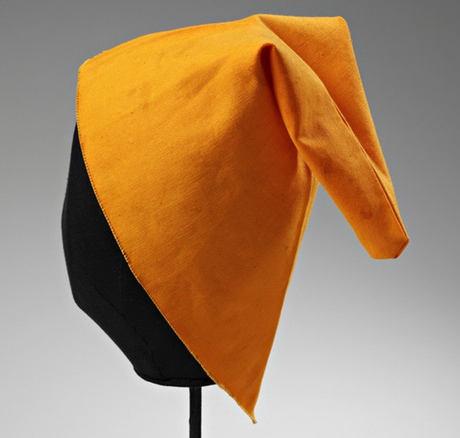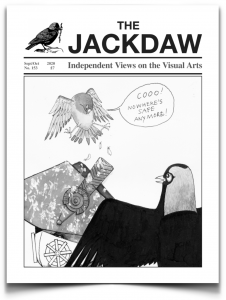It is understandable that, in current circumstances, major arts institutions should try to ally themselves with the more anarchic, contrarian elements in contemporary culture. Perhaps this is especially true of those dealing with the contemporary visual arts, committed as these still are to the myth of ‘avant-gardism’. One problem that immediately presents itself, of course, is that this myth is not itself contemporary – it is rooted in the very earliest years of the century before ours, and first blossomed before the outbreak of World War I. The myth has become so diversified in the course of more than a century of growth that what is indisputably avant garde today has become very difficult to define. One man’s ‘avant garde’ can easily be his neighbour’s idea of ho-hum, follow-my-leader conservatism.
Another problem, allied to the first, is that the history of the 20th century avant garde was rather specifically a history of élites. Avant-garde artists relied on élite patrons for financial support – independently wealthy, high status individuals who were conscious of the fact that their championship of the radically new distinguished them from the mass. There is also the fact that the now-classical avant-garde art movements initially embraced right wing politics more enthusiastically than they did left wing ones. This was the case with Italian Futurism, the most publicised of the early avant-gardes. Later, when avant-garde artists began to identify with the left, it was nevertheless would-be mass movements, Nazism and Soviet Communism, which were particularly hostile to avant-garde art. When Surrealism tried to sustain an alliance with Communism, the relationship was always extremely uneasy.
Disobedient Objects at the V&A (until February 1st) shows that this uneasiness has not gone away. Housed in one of London’s most important museums, its organisers have gone to some lengths to emphasise its democratic status. It is free entry, like the rest of the permanent collection (but unlike the other special exhibitions the museum offers as part of its regular programme), and it has been given an unusually long run – six months in all.
What it offers is an anthology of objects connected will all sorts of anarchic projects, from the anti-nuclear protests at Greenham Common in England, to the Mothers of the Disappeared in Buenos Aires – all challenges to some kind of existing status quo, made in many different contemporary societies and national entities, democratic and non-democratic. Most of the objects concerned would not normally be classified as art, or even as craft or design. In fact, what one has here is a kind of religious treasury – the holy relics of a number of recent episodes of social agitation, some of which succeeded in their aims and some of which failed. If Christ had lived in our own times, it wouldn’t be surprising to find a relic of the True Cross as part of the display – always remembering that this now sacred item wasn’t, and was never intended to be, a work of art, despite the numberless times it has since been depicted in art. I say this in the full consciousness that, to anyone who reads the Gospels carefully, the texts do in fact seem to advocate a radical egalitarian revolution in society. This despite the famous verse that tells the convert to: “Render unto Cesar the things that are Cesar’s, and unto God the things that are God’s.” [Matthew 22:21].
The introduction to the catalogue, by the two curators, Catherine Flood and Gavin Grindon, shows a queasy consciousness of this situation. On the one hand they say:
“The position of this project, both ‘within and against’ an institution, emerges principally from careful attention to these objects [included] and their own and their own instituent power.”
On the other they declare:
“Exhibitions are moments of collective meaning-making. Bringing these objects and histories together, and presenting them to an audience that never encounters them outside the mass media, makes the museum a site for difficult questions and tests it claim to be a public space.”
The phrase that betrays something here is “never encounters them outside the mass media”. The assumption seems to be that what is experienced within the sanctified space of the museum must necessarily be superior to the same thing experienced outside it. In other words, the official framework, just because it is official, offers a validation unobtainable in the non-official circumstances in which these ‘disobedient objects’ were first made. This paradox is a step too far. The objects concerned have, on the whole, no aesthetic value. They may have had force within the very specific contexts that provoked their production. But not here. They are dead fish on a slab. In an interview given in conjunction with the show, Catherine Flood claimed that the items displayed had not been ‘museumified’ – her word, not mine. I beg to differ. That is exactly what has happened.
One reason for this is the kind of public that great museums attract. They like to pretend that they are for ‘everyone’, and this is indeed why, in democratic Western European societies, they are given large sums of taxpayers’ money. Any observant person knows, however, that this ‘everyone’ is not completely universal. Museums attract the kind of citizens every democracy would like to have, perhaps to the exclusion of other, more difficult cases. They pull in the bien pensants – people who get a nice glow from the idea of going there. Certainly not the bulk of the truly disadvantaged, the real outsiders. They get a much higher proportion of middle-class visitors than working-class ones, though this distinction is slowly breaking down.
Where immediate, visceral access to the ideas being put forward in the show is concerned, the mass media win the contest, hands down. They know how to hit the public in the gut, and they operate in a fully public arena. You run up against them in your daily life, whether you want to or not.
What the museum does here is to try to organise the ‘disobedient’ material to make it palatable to the kind of visitors museums already get. Having heard about the show, you have to make the decision to go, even though you don’t have to pay a fee for the experience. Which means, in turn, that your mind is probably made up about the ideas it puts forward, long before you arrive.
As it happens, London has already seen a rather similar exhibition – Mark Wallinger’s Turner Prize-winning exhibit at Tate Britain in 2007. This, entitled State Britain, was a meticulous reconstruction of the ‘Peace Camp’ set up by the late activist Brian Haw in front of the Houses of Parliament, in protest against the Iraq War, and subsequently dismantled by the police because it contravened a hastily passed law against “unauthorised demonstrations within a one kilometre radius of Parliament Square”. Much play was made with the fact that the site of the installation within the museum building also seemed to fall within the forbidden zone. However, as the critic Tim Teeman, writing in The Times, remarked, “moving Haw’s protest from the street to the hallowed hush of the Tate denudes it of rawness and energy. The riot of colour, the anarchy of words and images, are dimmed; the weatherbeaten plastic coverings aren’t flapping in the wind anymore, but listlessly reflecting gallery spotlights.” He concluded by asking: “Does it ask new questions or challenge our preconceptions?” And answered his own query: “No, it merely confirms the liberal consensus.” This is exactly what has happened at the V & A, the second time round.
In fact Disobedient Objects is a very good example of that hallowed middle-class liberal pastime – preaching to the converted. It claims to be radical and is in fact deeply conventional and self-congratulatory. It won’t change anyone’s mind.
Edward Lucie-Smith
The Jackdaw Nov/Dec 2014



